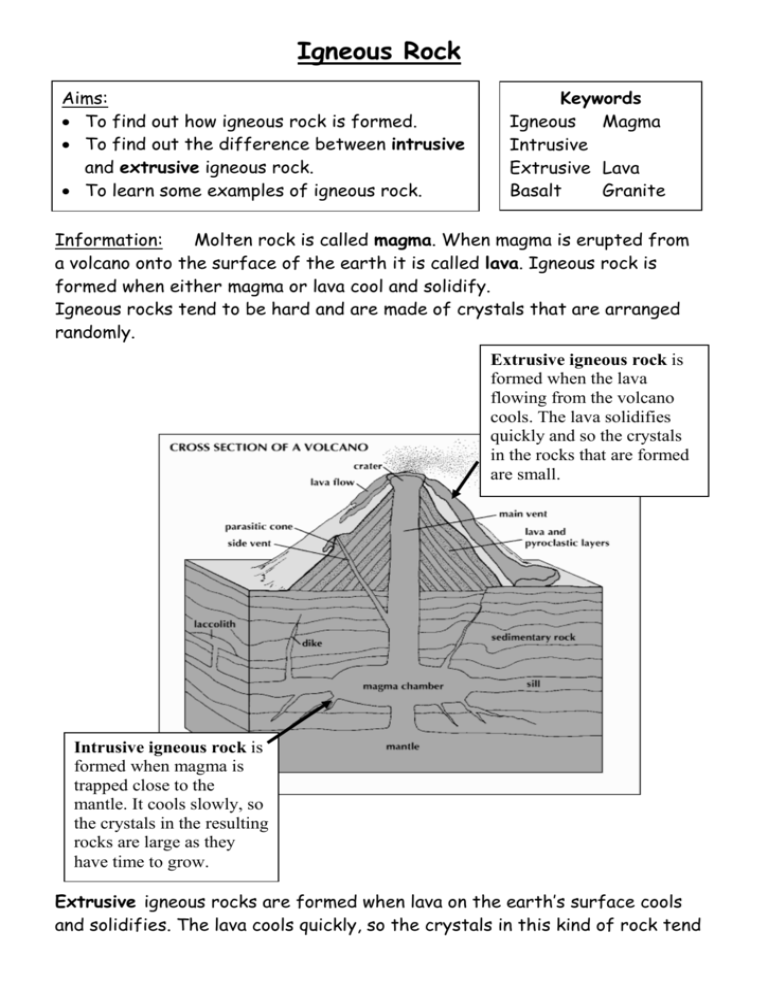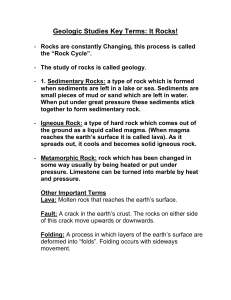Igneous Rock - Thurman Science Resources
advertisement

Igneous Rock Aims: To find out how igneous rock is formed. To find out the difference between intrusive and extrusive igneous rock. To learn some examples of igneous rock. Keywords Igneous Magma Intrusive Extrusive Lava Basalt Granite Information: Molten rock is called magma. When magma is erupted from a volcano onto the surface of the earth it is called lava. Igneous rock is formed when either magma or lava cool and solidify. Igneous rocks tend to be hard and are made of crystals that are arranged randomly. Extrusive igneous rock is formed when the lava flowing from the volcano cools. The lava solidifies quickly and so the crystals in the rocks that are formed are small. Intrusive igneous rock is formed when magma is trapped close to the mantle. It cools slowly, so the crystals in the resulting rocks are large as they have time to grow. Extrusive igneous rocks are formed when lava on the earth’s surface cools and solidifies. The lava cools quickly, so the crystals in this kind of rock tend to be small, as they do not have much time to grow. Basalt is an example of an extrusive igneous rock. The Giant’s Causeway in Northern Ireland was formed when a lava flow cooled. It is made of Basalt. The rock is grey and made of small, randomly arranged crystals. Intrusive igneous rocks are formed when magma forces its way into the earth’s crust. The magma cools slowly, as it is hotter inside the crust than on the earth’s surface. The crystals have more time to grow as the magma solidifies, so they are large. Granite is an example of an intrusive igneous rock. A sample of granite. Note the random pattern of large crystals. Granite has crystals made of different minerals. Tasks: Copy the title and aims. Answer the questions below as full sentences. Questions: 1. What are igneous rocks? 2. What is the difference between how intrusive and extrusive igneous rocks are formed? 3. How will intrusive and extrusive igneous rocks look different? 4. Explain why basalt has smaller crystals than granite. http://thurmanscience.tripod.com Sedimentary Rock Aims: To find out how sedimentary rock is formed. To learn the names of some types of sedimentary rock. To find out how fossils are formed and how these can help to age the rock. Keywords Weathering Erosion Sediments Transportation Deposition Burial Information: A process summarised in the four steps below forms sedimentary rocks. 1. Rock is broken up and worn away by the action of water, ice or wind. These processes are called weathering and erosion. 2. The small pieces of rock are called sediments. Rivers carry the sediments, to the sea. This process is called transportation. 3. The sediments sink to the seabed. This is called deposition. 4. The sediments are constantly being covered over as new layers of sediment are deposited. This is called burial. The weight of the layers above squeezes water out of the sediments. The sediment particles become stuck or cemented together by salts crystallising out of the water. This results in layers of sedimentary rock being formed. The process may take millions of years. The younger layers of rock tend to be found on top of the older layers. The layers of sedimentary rock can be seen clearly in the face of the cliff (left). Fossils and the ageing of rock: The sediments can also bury the remains of animals and plants. They become trapped and preserved in the resulting sedimentary rock as fossils. Each layer of rock preserves the organisms from the time that the sediment was laid down. The same kinds of fossils will be preserved in rocks of the same age even from different sites. Fossils can therefore be used to date sedimentary rocks. The fossilised horse (left) was found in deposits at the bottom of an ancient lake. It dates back 49 million years. Types of sedimentary rock The sedimentary rock that is made depends upon which sediments formed them. There are many different types of sedimentary rock. They all tend to have visible grains in them and they usually crumbly. Sandstone is formed from particles of sand. The grains of sand are visible to the naked eye and they can be rubbed off easily. Calico (right) is a type of sandstone that is made of different layers. Sandstone sometimes contains fossils. Limestone is made from the remains of animals that had shells and some calcium salts. Often the shells of the animals can be seen within the rock, as in shell limestone (right). Limestone often contains fossils. Tasks Copy the title and aims. Answer the questions below. Questions 1. What is meant by (a) Sediments (b) Erosion (c) Deposition (d) Transportation? 2. What are the properties of sedimentary rocks? How do they differ from the properties of igneous rocks? 3. Explain how sandstone is formed over millions of years. 4. Explain how fossils can be used to date sedimentary rocks. http://thurmanscience.tripod.com Metamorphic Rock Aims: To find out how metamorphic rocks are made. To learn some examples of metamorphic rocks. To learn the properties of metamorphic rocks. Keywords Compressed magma Information: Metamorphic rocks are formed due to extreme temperature and pressure acting on other kinds of rock. The movement of tectonic plates can force rocks deep underground. The rocks are heated by the magma below. They are also squashed by rocks above and by the plate movement. The rocks are therefore compressed and heated, which changes both their structure and their texture. Metamorphic rocks are usually hard. They contain small crystals that often line up and can be seen as visible bands. The bands can be seen clearly in this metamorphic rock called schist. The kind of metamorphic rock made depends on which rock has been squashed and heated. Slate is the metamorphic rock that is formed when Mudstone is compressed and heated. Slate is hard but it can be split easily, as it is made up of layers. Slate tends to split in thin parallel layers, so it is useful for making roof tiles or blackboards. When limestone is squashed and heated, the rock formed is called marble. Marble is grey or white in colour but may have streaks of colour. Marble is made of small crystals that often form bands. Sculptors prized the Italian white marble (left). Tasks: Copy the title and aims. Answer the questions below as full sentences. Questions: 1. Explain how metamorphic rocks are formed. 2. What are the characteristics of metamorphic rocks? 3. What is slate? How is it formed? 4. What is marble? How is it formed? Glossary Compressed – to be squashed Magma – molten rock http://thurmanscience.tripod.com








